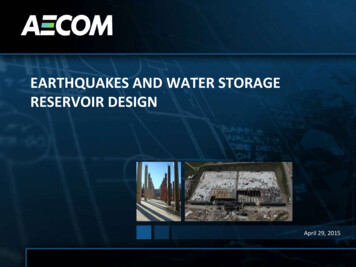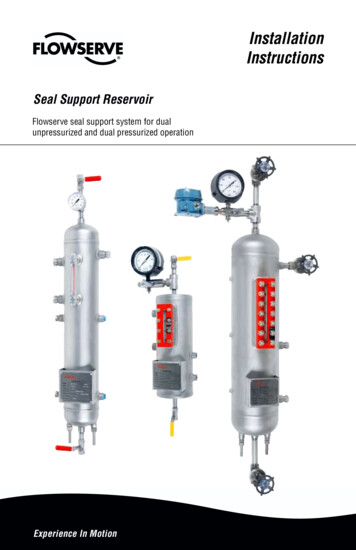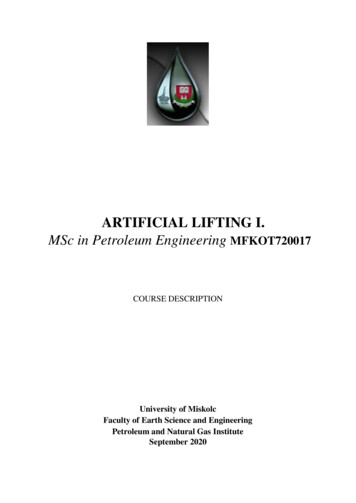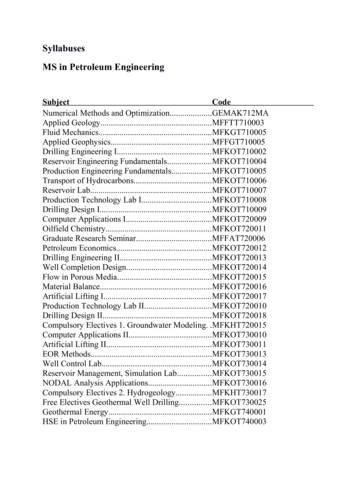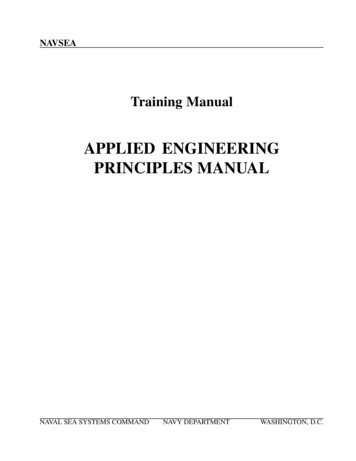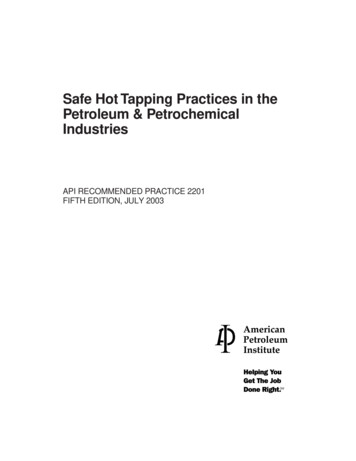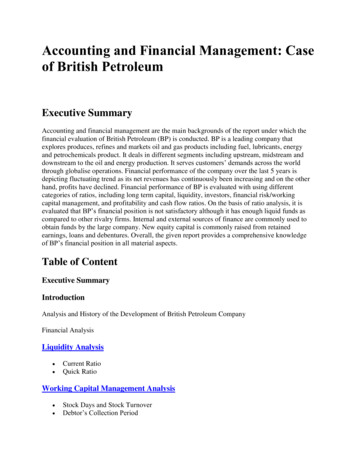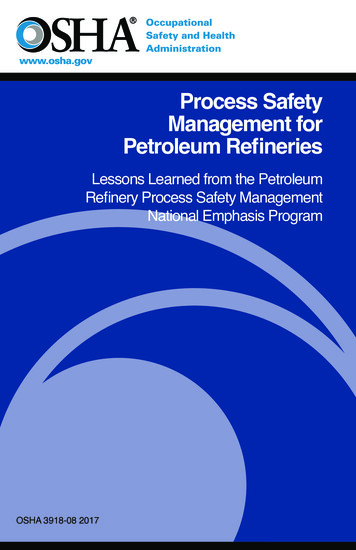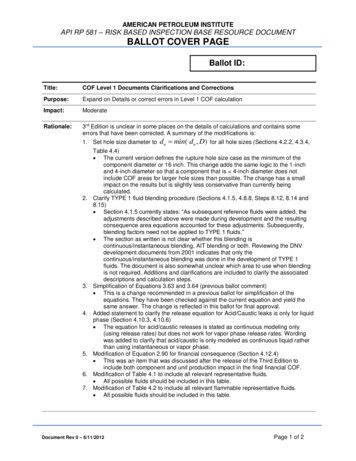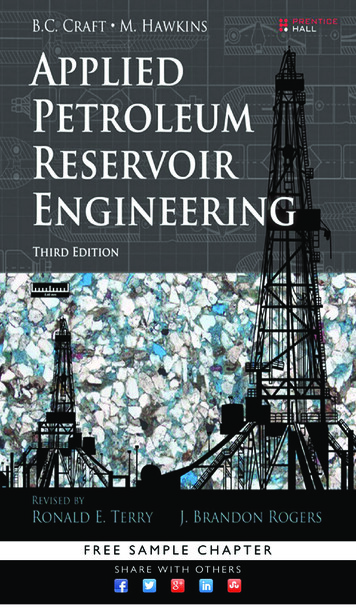
Transcription
Applied Petroleum Reservoir EngineeringThird Edition
This page intentionally left blank
Applied Petroleum Reservoir EngineeringThird EditionRonald E. TerryJ. Brandon RogersUpper Saddle River, NJ Boston Indianapolis San FranciscoNew York Toronto Montreal London Munich Paris MadridCapetown Sydney Tokyo Singapore Mexico City
Many of the designations used by manufacturers and sellers to distinguishtheir products are claimed as trademarks. Where those designations appear in this book, and the publisher was aware of a trademark claim, thedesignations have been printed with initial capital letters or in all capitals.Executive EditorBernard GoodwinThe authors and publisher have taken care in the preparation of this book,but make no expressed or implied warranty of any kind and assume no responsibility for errors or omissions. No liability is assumed for incidentalor consequential damages in connection with or arising out of the use ofthe information or programs contained herein.Project EditorElizabeth RyanFor information about buying this title in bulk quantities, or for specialsales opportunities (which may include electronic versions; custom coverdesigns; and content particular to your business, training goals, marketingfocus, or branding interests), please contact our corporate sales department at corpsales@pearsoned.com or (800) 382-3419.For government sales inquiries, please contact governmentsales@pearsoned.com.For questions about sales outside the U.S., please contact international@pearsoned.com.Visit us on the Web: informit.com/phLibrary of Congress Cataloging-in-Publication DataTerry, Ronald E.Applied petroleum reservoir engineering / Ronald E. Terry, J. BrandonRogers.—Third edition.pages cmOriginal edition published: Applied petroleum reservoir engineering /by B.C. Craft and M.F. Hawkins. 1959.Includes bibliographical references and index.ISBN 978-0-13-315558-7 (hardcover : alk. paper)1. Petroleum engineering. 2. Oil reservoir engineering. I. Rogers,J. Brandon. II. Craft, B. C. (Benjamin Cole) III. Title.TN870.C88 2014622'.338—dc232014017944Copyright 2015 Pearson Education, Inc.All rights reserved. Printed in the United States of America. This publication is protected by copyright, and permission must be obtained fromthe publisher prior to any prohibited reproduction, storage in a retrievalsystem, or transmission in any form or by any means, electronic, mechanical, photocopying, recording, or likewise. To obtain permission touse material from this work, please submit a written request to PearsonEducation, Inc., Permissions Department, One Lake Street, Upper SaddleRiver, New Jersey 07458, or you may fax your request to (201) 236-3290.ISBN-13: 978-0-13-315558-7ISBN-10: 0-13-315558-7Text printed in the United States on recycled paper at Courier in Westford,Massachusetts.First printing, August 2014Managing EditorJohn FullerCopy EditorScribe Inc.IndexerScribe Inc.ProofreaderScribe Inc.Technical ReviewersChristine EconomidesKegang LingEditorial AssistantMichelle HousleyCover DesignerAlan ClementsCompositorScribe Inc.
To Rebecca and JaLeen
This page intentionally left blank
ContentsPrefacePreface to the Second EditionAbout the AuthorsNomenclaturexiiixvxviixixChapter 1 Introduction to Petroleum Reservoirs and Reservoir Engineering1.1 Introduction to Petroleum Reservoirs1.2 History of Reservoir Engineering1.3 Introduction to Terminology1.4 Reservoir Types Defined with Reference to Phase Diagrams1.5 Production from Petroleum Reservoirs1.6 Peak OilProblemsReferences1147913141819Chapter 2 Review of Rock and Fluid Properties2.1 Introduction2.2 Review of Rock Properties2.2.1 Porosity2.2.2 Isothermal Compressibility2.2.3 Fluid Saturations2.3 Review of Gas Properties2.3.1 Ideal Gas Law2.3.2 Specific Gravity2.3.3 Real Gas Law2.3.4 Formation Volume Factor and Density2.3.5 Isothermal Compressibility2.3.6 Viscosity21212122222424242526343541vii
viiiContents2.4 Review of Crude Oil Properties2.4.1 Solution Gas-Oil Ratio, Rso2.4.2 Formation Volume Factor, Bo2.4.3 Isothermal Compressibility2.4.4 Viscosity2.5 Review of Reservoir Water Properties2.5.1 Formation Volume Factor2.5.2 Solution Gas-Water Ratio2.5.3 Isothermal Compressibility2.5.4 Viscosity2.6 SummaryProblemsReferencesChapter 3 The General Material Balance Equation3.1 Introduction3.2 Derivation of the Material Balance Equation3.3 Uses and Limitations of the Material Balance Method3.4 The Havlena and Odeh Method of Applyingthe Material Balance EquationReferencesChapter 4 Single-Phase Gas Reservoirs4.1 Introduction4.2 Calculating Hydrocarbon in Place Using Geological,Geophysical, and Fluid Property Data4.2.1 Calculating Unit Recovery from Volumetric Gas Reservoirs4.2.2 Calculating Unit Recovery fromGas Reservoirs under Water Drive4.3 Calculating Gas in Place Using Material Balance4.3.1 Material Balance in Volumetric Gas Reservoirs4.3.2 Material Balance in Water-Drive Gas Reservoirs4.4 The Gas Equivalent of Produced Condensate and Water4.5 Gas Reservoirs as Storage 878891939898100105107
Contents4.6 Abnormally Pressured Gas Reservoirs4.7 Limitations of Equations and ErrorsProblemsReferencesix110112113118Chapter 5 Gas-Condensate Reservoirs5.1 Introduction5.2 Calculating Initial Gas and Oil5.3 The Performance of Volumetric Reservoirs5.4 Use of Material Balance5.5 Comparison between the Predicted and ActualProduction Histories of Volumetric Reservoirs5.6 Lean Gas Cycling and Water Drive5.7 Use of Nitrogen for Pressure r 6 Undersaturated Oil Reservoirs6.1 Introduction6.1.1 Oil Reservoir Fluids6.2 Calculating Oil in Place and Oil Recoveries UsingGeological, Geophysical, and Fluid Property Data6.3 Material Balance in Undersaturated Reservoirs6.4 Kelly-Snyder Field, Canyon Reef Reservoir6.5 The Gloyd-Mitchell Zone of the Rodessa Field6.6 Calculations, Including Formation and Water r 7 Saturated Oil Reservoirs7.1 Introduction7.1.1 Factors Affecting Overall Recovery7.2 Material Balance in Saturated Reservoirs7.2.1 The Use of Drive Indices in Material Balance 1177184191197
xContents7.3 Material Balance as a Straight Line7.4 The Effect of Flash and Differential Gas Liberation Techniquesand Surface Separator Operating Conditions on Fluid Properties7.5 The Calculation of Formation Volume Factor and SolutionGas-Oil Ratio from Differential Vaporization and Separator Tests7.6 Volatile Oil Reservoirs7.7 Maximum Efficient Rate (MER)ProblemsReferencesChapter 8 Single-Phase Fluid Flow in Reservoirs8.1 Introduction8.2 Darcy’s Law and Permeability8.3 The Classification of Reservoir Flow Systems8.4 Steady-State Flow8.4.1 Linear Flow of Incompressible Fluids, Steady State8.4.2 Linear Flow of Slightly Compressible Fluids, Steady State8.4.3 Linear Flow of Compressible Fluids, Steady State8.4.4 Permeability Averaging in Linear Systems8.4.5 Flow through Capillaries and Fractures8.4.6 Radial Flow of Incompressible Fluid, Steady State8.4.7 Radial Flow of Slightly Compressible Fluids, Steady State8.4.8 Radial Flow of Compressible Fluids, Steady State8.4.9 Permeability Averages for Radial Flow8.5 Development of the Radial Diffusivity Equation8.6 Transient Flow8.6.1 Radial Flow of Slightly Compressible Fluids, Transient Flow8.6.2 Radial Flow of Compressible Fluids, Transient Flow8.7 Pseudosteady-State Flow8.7.1 Radial Flow of Slightly Compressible Fluids,Pseudosteady-State Flow8.7.2 Radial Flow of Compressible Fluids, Pseudosteady-State Flow8.8 Productivity Index (PI)8.8.1 Productivity Ratio 42244246247248249251253254260261262264264266
Contents8.9 Superposition8.9.1 Superposition in Bounded or Partially Bounded Reservoirs8.10 Introduction to Pressure Transient Testing8.10.1 Introduction to Drawdown Testing8.10.2 Drawdown Testing in Pseudosteady-State Regime8.10.3 Skin Factor8.10.4 Introduction to Buildup 2292Chapter 9 Water Influx9.1 Introduction9.2 Steady-State Models9.3 Unsteady-State Models9.3.1 The van Everdingen and Hurst Edgewater Drive Model9.3.2 Bottomwater Drive9.4 Pseudosteady-State 6Chapter 10 The Displacement of Oil and Gas10.1 Introduction10.2 Recovery Efficiency10.2.1 Microscopic Displacement Efficiency10.2.2 Relative Permeability10.2.3 Macroscopic Displacement Efficiency10.3 Immiscible Displacement Processes10.3.1 The Buckley-Leverett Displacement Mechanism10.3.2 The Displacement of Oil by Gas, with and withoutGravitational Segregation10.3.3 Oil Recovery by Internal Gas Drive10.4 76382399399402
xiiContentsChapter 11 Enhanced Oil Recovery11.1 Introduction11.2 Secondary Oil Recovery11.2.1 Waterflooding11.2.2 Gasflooding11.3 Tertiary Oil Recovery11.3.1 Mobilization of Residual Oil11.3.2 Miscible Flooding Processes11.3.3 Chemical Flooding Processes11.3.4 Thermal Processes11.3.5 Screening Criteria for Tertiary Processes11.4 21427431433434434Chapter 12 History Matching12.1 Introduction12.2 History Matching with Decline-Curve Analysis12.3 History Matching with the Zero-DimensionalSchilthuis Material Balance Equation12.3.1 Development of the Model12.3.2 The History Match12.3.3 Summary Comments Concerning History-Matching 71Glossary473Index481
PrefaceAs in the first revision, the authors have tried to retain the flavor and format of the original text. Thetext contains many of the field examples that made the original text and the second edition so popular.The third edition features an introduction to key terms in reservoir engineering. This introduction has been designed to aid those without prior exposure to petroleum engineering to quicklybecome familiar with the concepts and vocabulary used throughout the book and in industry. In addition, a more extensive glossary and index has been included. The text has been updated to reflectmodern industrial practice, with major revisions occurring in the sections regarding gas condensatereservoirs, waterflooding, and enhanced oil recovery. The history matching examples throughoutthe text and culminating in the final chapter have been revised, using Microsoft Excel with VBA asthe primary computational tool.As an introduction to the material balance approach of Applied Petroleum Reservoir Engineering, Third Edition, the purpose of the book has been and continues to be to prepare engineeringstudents and practitioners to understand and work in petroleum reservoir engineering. The bookbegins with an introduction to key terms and an introduction to the history of reservoir engineering.The material balance approach to reservoir engineering is covered in detail and is applied in turn toeach of four types of reservoirs. The latter half of the book covers the principles of fluid flow, water influx, and advanced recovery techniques. The last chapter of the book brings together the keytopics in a history matching exercise that requires matching the production of wells and predictingthe future production from those wells.In short, the book has been updated to reflect current practices and technology and is morereader friendly, with introductions to vocabulary and concepts as well as examples using MicrosoftExcel with VBA as the computational tool.—Ronald E. Terry and J. Brandon Rogersxiii
This page intentionally left blank
Preface to the Second EditionShortly after undertaking the project of revising the text Applied Petroleum Reservoir Engineeringby Ben Craft and Murray Hawkins, several colleagues expressed the wish that the revision retainthe flavor and format of the original text. I am happy to say that I have attempted to do just that.The text contains many of the field examples that made the original text so popular and still morehave been added. The revision includes a reorganization of the material as well as updated materialin several chapters.The chapters were reorganized to follow a sequence used in a typical undergraduate course inreservoir engineering. The first chapters contain an introduction to reservoir engineering, a reviewof fluid properties, and a derivation of the general material balance equation. The next chapterspresent information on applying the material balance equation to different reservoir types. Theremaining chapters contain information on fluid flow in reservoirs and methods to predict hydrocarbon recoveries as a function of time.There were some problems in the original text with units. I have attempted to eliminate theseproblems by using a consistent definition of terms. For example, formation volume factor is expressed in reservoir volume/surface condition volume. A consistent set of units is used throughoutthe text. The units used are ones standardized by the Society of Petroleum Engineers.I would like to express my sincere appreciation to all those who have in some part contributed to the text. For their encouragement and helpful suggestions, I give special thanks to the following colleagues: John Lee at Texas A&M; James Smith, formerly of Texas Tech; Don Green andFloyd Preston of the University of Kansas; and David Whitman and Jack Evers of the Universityof Wyoming.—Ronald E. Terryxv
This page intentionally left blank
About the AuthorsRonald E. Terry worked at Phillips Petroleum researching enhanced oil recovery processes. Hetaught chemical and petroleum engineering at the University of Kansas; petroleum engineering atthe University of Wyoming, where he wrote the second edition of this text; and chemical engineering and technology and engineering education at Brigham Young University, where he cowrote thethird edition of this text. He received teaching awards
12.2 History Matching with Decline-Curve Analysis 438 12.3 History Matching with the Zero-Dimensional Schilthuis Material Balance Equation 441 12.3.1 Development of the Model 441 12.3.2 The History Match 443 12.3.3 Summary Comments Concerning History-Matching Example 465 Problems 466 References 471 Glossary 473 Index 481
